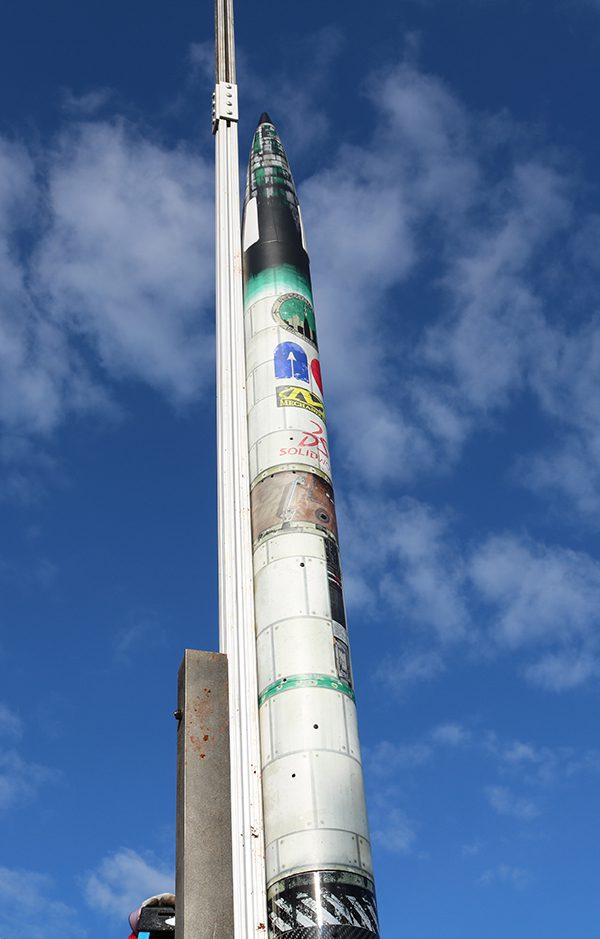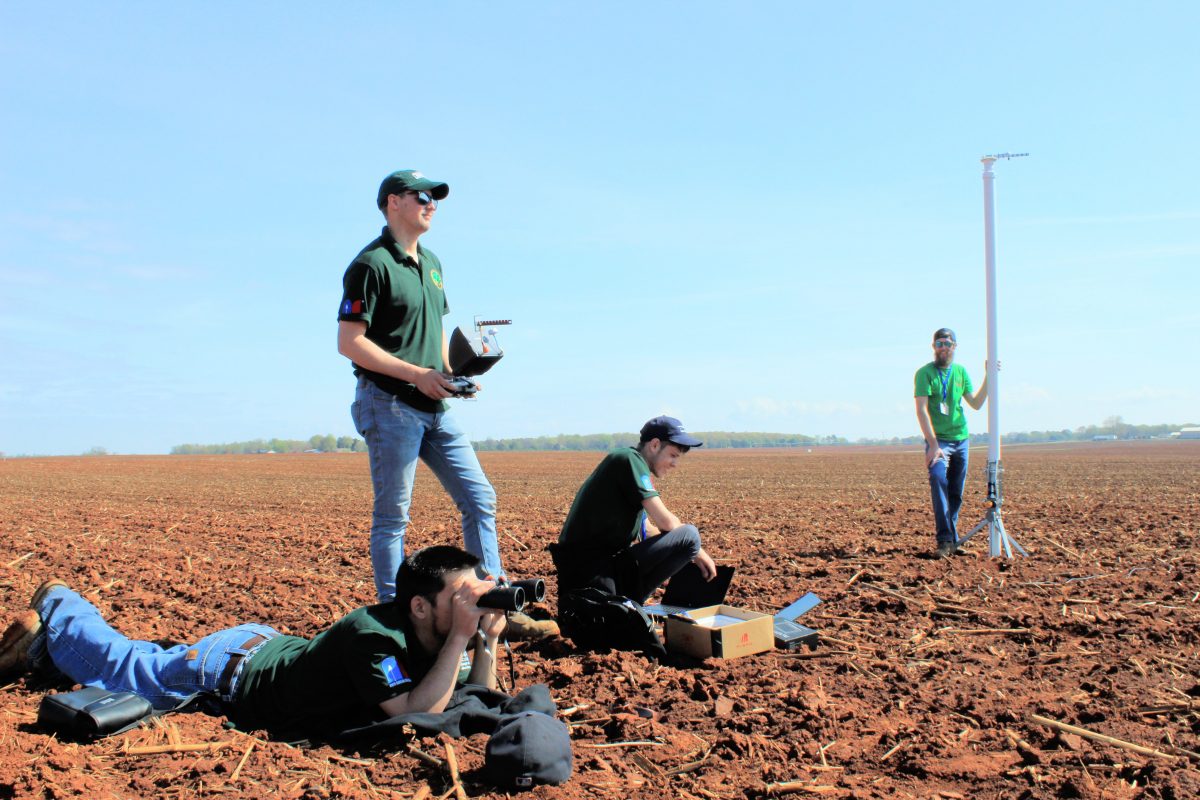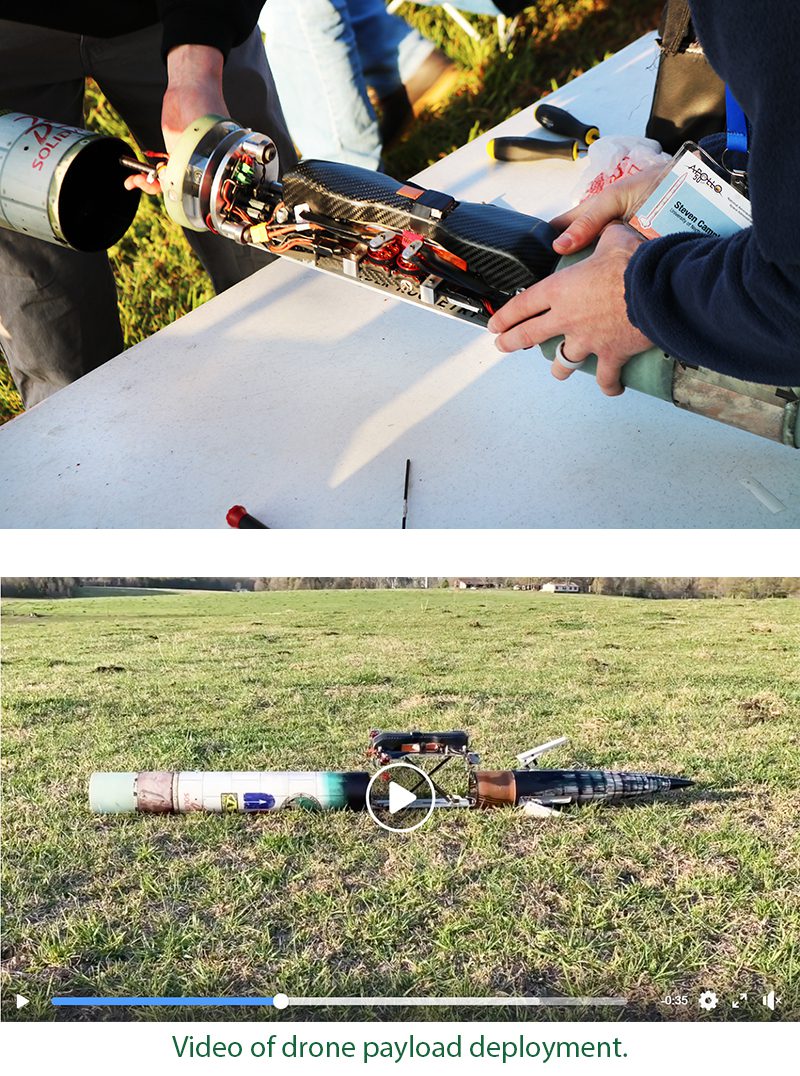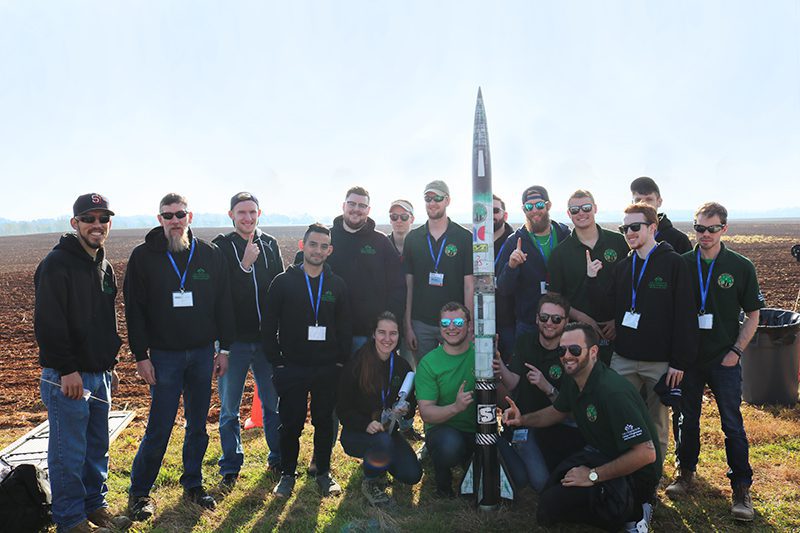49er Rocketry Team Places High at NASA Event

The 49er Rocketry Team had a successful competition on April 6th, as its rocket and payload performed well and scored high at the NASA Student Launch Competition. The UNC Charlotte team finished second overall at the competition.
Forty-five teams from 20 states took part in the Student Launch Competition, held at Marshall Space Flight Center in Huntsville, Alabama. For the 2018-19 competition, teams had to design, build and test a rocket and payload while meeting multiple documentation and review criteria. Teams had to predict the altitude their rocket would fly to, and deploy either a rover or flying drone payload.
 UNC Charlotte was the first university to launch. The 49er rocket’s altitude was within 130 feet of predicted apogee. The payload section recovery worked exactly as designed and the unmanned aerial vehicle (UAV or drone) successfully deployed and delivered its navigational beacon to the required target location.
UNC Charlotte was the first university to launch. The 49er rocket’s altitude was within 130 feet of predicted apogee. The payload section recovery worked exactly as designed and the unmanned aerial vehicle (UAV or drone) successfully deployed and delivered its navigational beacon to the required target location.
In the preliminary results, the 49er team was recognized with:
- 1st Place – Safety Award
- 1st Place – Payload Design
- 2nd Place – Project Review
- 3rd Place – STEM Engagement
- 3rd Place – Best Looking Rocket
- 2nd Place – Overall
The project lead for the UNC Charlotte team was mechanical engineering student Kyle Kalish. Here is his account of the 2018-19 team’s experience:
“For the 2018-19 NASA Student Launch competition, the 49er Rocketry Team was tasked with designing a launch vehicle and recovery system that housed an unmanned aerial vehicle (UAV) capable of flying a simulated navigational beacon to a NASA specified Future Excursion Area, which was a brightly colored yellow tarp on the launch field.
 “For the launch vehicle, we were required to both design the launch vehicle and declare the altitude that we thought it would reach. We were determined to design the most aerodynamic and volumetrically efficient vehicle we could. We ran multiple computational fluid dynamic simulations on nose cone, fin and boat tail designs to determine which configuration would be the best for flight. In addition, the volumetric optimization of the launch vehicle was a main focus, as every cubic inch of wasted space in the vehicle can be considered wasted money. With this, we were able to condense all our systems into a 4.63 inch diameter airframe with an overall weight of 44.4 pounds, declaring our anticipated altitude to be 4,200 ft.
“For the launch vehicle, we were required to both design the launch vehicle and declare the altitude that we thought it would reach. We were determined to design the most aerodynamic and volumetrically efficient vehicle we could. We ran multiple computational fluid dynamic simulations on nose cone, fin and boat tail designs to determine which configuration would be the best for flight. In addition, the volumetric optimization of the launch vehicle was a main focus, as every cubic inch of wasted space in the vehicle can be considered wasted money. With this, we were able to condense all our systems into a 4.63 inch diameter airframe with an overall weight of 44.4 pounds, declaring our anticipated altitude to be 4,200 ft.
 “For the payload, we went through a few design concepts, including a split airframe configuration, before choosing the UAV and deployment system. The UAV consisted of six subsystems: Object Detection and Avoidance, Ground Control, FEA Detection, Drive System, and Beacon Retention and Deployment. These systems worked in unison to allow for an autonomous take off, flight and beacon release. Mechanically, the UAV had a carbon fiber frame, folding arms and a protective shell to protect the integrity of the electrical components. The UAV deployment had six subsystems: Retention, Separation, Orientation, Stabilization, Table Lift and Arm Deployment. The systems worked to ensure that the UAV would be safely retained during flight, and be able to safely take off from the launch vehicle without any obstructions.
“For the payload, we went through a few design concepts, including a split airframe configuration, before choosing the UAV and deployment system. The UAV consisted of six subsystems: Object Detection and Avoidance, Ground Control, FEA Detection, Drive System, and Beacon Retention and Deployment. These systems worked in unison to allow for an autonomous take off, flight and beacon release. Mechanically, the UAV had a carbon fiber frame, folding arms and a protective shell to protect the integrity of the electrical components. The UAV deployment had six subsystems: Retention, Separation, Orientation, Stabilization, Table Lift and Arm Deployment. The systems worked to ensure that the UAV would be safely retained during flight, and be able to safely take off from the launch vehicle without any obstructions.
“We conducted many subsystem tests before doing any full system tests to ensure everything would work as intended. All subsystem testing was completely successfully and demonstration flights were conducted for the launch vehicle and payload, both being a complete success.
“The competition was held on April 6th in Huntsville, Alabama, the home of Marshall Space Center. The competition launch was successful, with the launch vehicle ascending to 4,072 ft., which was only 128 ft. off our declared altitude. The payload was also able to successfully deploy the UAV, fly to the Future Excursion Area, and drop the beacon onto it.
“As a whole, the team is extremely happy and proud of the awards received so far, but not satisfied just yet. With one more document left to be written and graded, we are all hungry and ready to make one last push to try and win the overall award for the first time in the history of the university. We couldn’t have gotten where we are without the help of the following: All our crowdfunding supporters, Dr. Jerry Dahlberg, the University of North Carolina at Charlotte, The William States Lee College of Engineering, NC Space Grant, Solidworks, and Mechanix Wear.”
The 49er Rocketry Team members were:
- Kyle Kalish
- Charles Ogino
- Kyrah Ford
 Steven Campbell
Steven Campbell- Cameron Palkowski
- Mitchell Collins
- David Cardenas
- Dmitri Gutuleac
- Robert Cook
- Richard Bastian
- Kohl Whitlow
- William Blalock
- William Timms
- Daniel Cornett
- Alexander DeChant
- David Black
- Darrin Leer
- Jonas Bell
For more information about NASA’s Student Launch, visit https://www.nasa.gov/education/studentlaunch
Archived launch-day footage will be available on NASA’s Student Launch Facebook account at https://www.facebook.com/NASAStudentLaunch/
 Steven Campbell
Steven Campbell